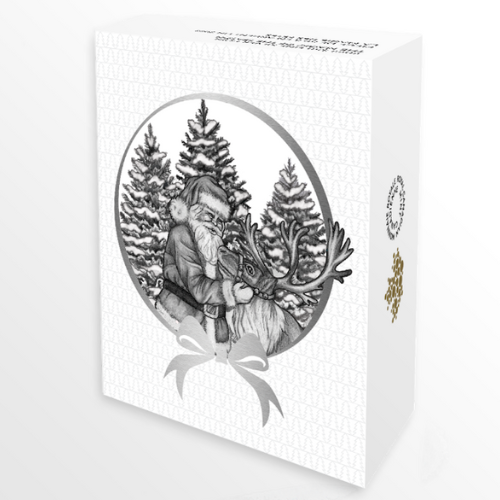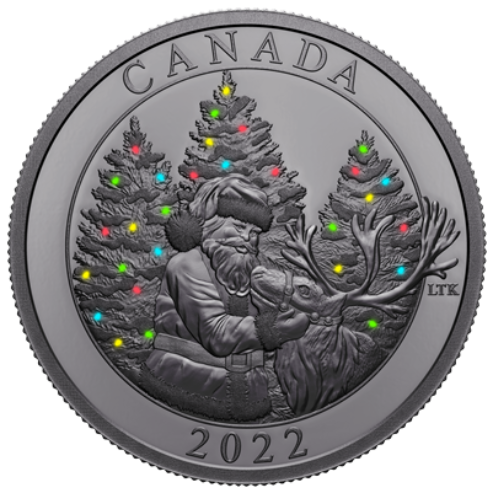Last updated on May 2nd, 2024 at 03:31 pm
Last Updated on May 2, 2024 Posted by Colonial Acres Coins
For children, there is nothing as wonderful as the fun of waking up on Christmas morning and seeing what surprises Santa Claus has left for them. Some people say that Santa Claus isn’t real, but even if some of the stories about him are embellished, he was based on a historical figure, so the legend has a basis in fact. The Royal Canadian Mint celebrates Santa Claus and the joy his storied exploits have brought to children for hundreds of years with a commemorative $50 silver coin that offers its own special holiday surprise.
The Origins of Santa Claus
The name “Santa Claus” derives from the Dutch “Sinter Kl
aas,” itself a shortened form of “Sint Nikolaas,” or Saint Nicholas in English. Saint Nicholas was a third-century Turkish monk. In life, he was renowned for his faith in God and his kindness to others. In death, he was canonized by the Church and designated the patron saint of children. His feast day is December 6th, approximately three weeks before Christmas.
Saint Nicholas became popular throughout Europe. He was particularly venerated in Holland, where it is traditional to celebrate his feast day with family parties and gift exchanges. Children leave their shoes by the window for Saint Nicholas to fill with gifts, and Saint Nicholas (or a costumed proxy), makes visits to department stores, hospitals, and schools to talk to the children and find out if they have been good.
When Dutch immigrants started coming to North America, they brought their holiday traditions with them. The legend of Santa Claus and many other aspects of the festivities still persist today, only now they are more associated with Christmas than Saint Nicholas Day.
The Appearance of Santa Claus
 Though Saint Nicholas, or Santa Claus, figures prominently in many holiday traditions, until the 19th century, there was little agreement about what he looked like. Religious icons of Saint Nicholas date back centuries and often depict him wearing traditional priest’s vestments.
Though Saint Nicholas, or Santa Claus, figures prominently in many holiday traditions, until the 19th century, there was little agreement about what he looked like. Religious icons of Saint Nicholas date back centuries and often depict him wearing traditional priest’s vestments.
In 1822, an American author and Episcopal minister named Clement Moore wrote a poem called “An Account of a Visit From St. Nicholas.” The title was subsequently shortened to “A Visit From St. Nicholas” and is now often referred to by its opening line, “Twas the Night Before Christmas.” In any case, it described the visitor as plump, chubby, and elfin with a white beard on his chin.
About 60 years later, an American political cartoonist named Thomas Nast took inspiration from Moore’s poem to create his own visual representation of Santa Claus. It was Nast who drew Santa in the red suit with white fur trim that has since become identified with him around the world.
The Design of the Royal Canadian Mint’s Magic of the Season Coin
Designed by Lisa Thomson-Khan, the design of the commemorative Canadian coins depict Santa in the iconic fur-trimmed suit created for him by Thomas Nast. As described in Moore’s poem, he is plump with a broad face and a long beard. He is caring for one of his reindeer, but it is not evident which one. In the background are three snow-covered evergreen trees of the type usually used for Christmas decorations.
When viewed under normal lights, there is no colour evident in the engraving. However, when viewed under a black light, which is included with the coin, multicoloured lights appear, twinkling in the trees behind the “right jolly old elf” and his faithful animal sidekick, recreating the magic of Christmas for people of all ages.
The 50 Dollar Silver Coin Value
 While the Magic of the Season coin has a face value of 50 dollars, collectible coins are often worth much more than their face value. It is difficult to place a numerical value on the wonder and joyful memories that this coin can evoke. This is the season for buying holiday gifts for loved ones, and you can find the Magic of the Season coin at Colonial Acres.
While the Magic of the Season coin has a face value of 50 dollars, collectible coins are often worth much more than their face value. It is difficult to place a numerical value on the wonder and joyful memories that this coin can evoke. This is the season for buying holiday gifts for loved ones, and you can find the Magic of the Season coin at Colonial Acres.




